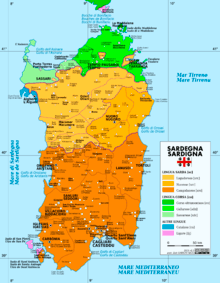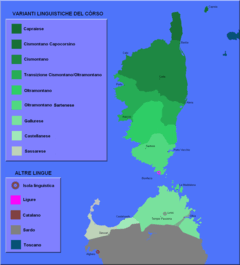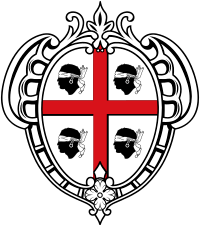Gallurese dialect
| Gallurese | |
|---|---|
| Gadduresu | |
| Native to | Italy |
| Region | Sardinia (Gallura) |
Native speakers | 100,000 (1999)[1] |
| Official status | |
Recognised minority language in | |
| Language codes | |
| ISO 639-3 |
sdn |
| Glottolog |
gall1276[2] |
| Linguasphere |
51-AAA-pd |
 Languages and dialects of Sardinia | |
Gallurese (gadduresu) is an Italo-Dalmatian Romance lect spoken in the region of Gallura, in the northeastern part of Sardinia. It is often considered a dialect of southern Corsican, or even a transitional language between Corsican and Sardinian.
Gallurese's morphology and vocabulary are close to those of Corsican, in particular with the southern dialects of Sartene and Porto-Vecchio, whereas its phonology and syntax are similar to those of Sardinian.[3] One third of Gallurese vocabulary is also influenced by Logudorese Sardinian, Catalan, and Spanish.[3]
The Sassarese language, spoken in the area of Sassari, shares similar transitional traits between Tuscan, Corsican and Sardinian.
Typical constitutional elements of Gallurese

- the plural form of nouns in -i (ghjanni or polti 'doors') are like in Corsican and Italian, and not as in -s like in Sardinian (jannas, portas), French, Spanish, Catalan, etc.
- Latin 'll' has become -dd- (like casteddu, coraddu 'castle', 'coral'), the same as in Sardinian, southern Corsican and Sicilian (but castellu, corallu in northern Corsican);
- -r- modified to -l- (poltu 'port', while portu in Corsican and Sardinian);
- -chj- and -ghj- sounds (ghjesgia 'church', occhji 'eyes'), like in Corsican, while Sardinian is cresia, ogros.
- articles lu, la, li, like in ancient Corsican dialects (u, a, i in modern Corsican, su, sa, sos, sas in Sardinian);
Relation to Corsican
Gallurese is classified by some linguists as a dialect of Corsican,[4][5][6] and by others as a dialect of Sardinian.[7] In any case, a great deal of similarity exists between Southern Corsican dialects and Gallurese, while there is relatively more distance from the neighbouring Sardinian varieties.
The Regional Government of Sardinia has recognized Gallurese, along with Sassarese as separate languages, distinct from Sardinian.[8]
Sample of text
An excerpt from a hymn dedicated to the Virgin Mary.[9]
| Standard Italian | Southern Corsican | Gallurese | Sassarese | Logudorese Sardinian | English translation |
|---|---|---|---|---|---|
|
Tu sei nata per incanto Sei tanto bella che ogni cuore Io sono vecchio e canuto Quanto campi devo fare La patrona di Gallura |
Tu sè nata par incantu Sè bedda chì ugni cori Ié socu vechju canutu Quantu campu devu fà A Patrona di Gaddura |
Tu sei nata par incantu Sei bedda chi dugna cori E socu vecchju canutu Cantu campu decu fà La Patrona di Gaddura |
Tu sei nadda pà incantu Sei bedda chi dugna cori E soggu vecciu canuddu Cantu campu aggiu da fà La Patrona di Gaddura |
Tue ses naschida pro incantu Ses bella gai chi dontzi coro E soe betzu e pili canu Pro cantu bivo appo a fàghere Sa patrona de Gallura |
You were born of enchantment You are so beautiful that every heart I am old and grey No matter how many fields I must till The Patron of Gallura |
History
The most ancient literary sources in Gallurese date back to the early 17th century, mainly as poetry and religious odes. Some late Middle Age fragments suggest that the formation of the language could be dated to the early 15th century. The origin and the development of Gallurese are debated. Max Leopold Wagner and Maurice Le Lannou argued that successive migration waves from Southern Corsica, promoted under the Aragonese rule to repopulate an area devastated by famine and pandemics, were crucial in the formation of a slightly hybridized version of Corsican.
See also
References
- ↑ Gallurese at Ethnologue (19th ed., 2016)
- ↑ Hammarström, Harald; Forkel, Robert; Haspelmath, Martin, eds. (2017). "Gallurese Sardinian". Glottolog 3.0. Jena, Germany: Max Planck Institute for the Science of Human History.
- 1 2 Atti Convegno Lingua Gallurese, Palau 2014
- ↑ Blasco Ferrer 1984: 180–186, 200
- ↑ Contini 1987: 1°, 500–503
- ↑ Dettori 2002
- ↑ Loporcaro 2009: 159–167
- ↑ Autonomous Region of Sardinia (1997-10-15). "Legge Regionale 15 ottobre 1997, n. 26" (in Italian). pp. Art. 2, paragraph 4. Retrieved 2008-06-16.
- ↑ "Accademia della lingua gallurese".
External links
- Maxia, Mauro. Studi sardo-corsi: Dialettologia e storia della lingua tra le due isole. Accademia della Lingua Gallurese; Istituto di Filologia (2010).
- Elementi di grammatica gallurese, Antoninu Rubattu
- Von Wartburg, Walther. La fragmentation linguistique de la Romania. Paris, Librairie C. Klincksieck, 1967.
